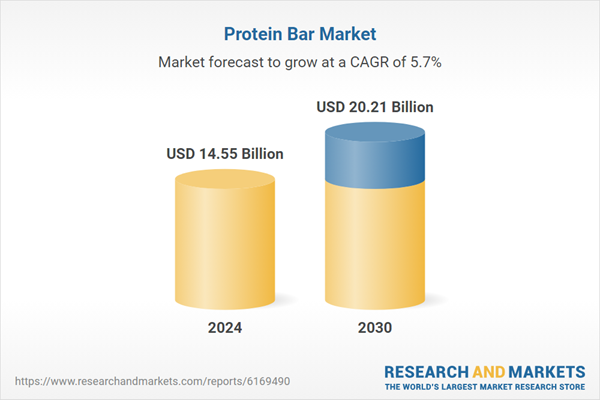Speak directly to the analyst to clarify any post sales queries you may have.
10% Free customizationThis report comes with 10% free customization, enabling you to add data that meets your specific business needs.
Americans frequently indulge in sweet snacks, averaging 6.4 occasions per week. Protein-fortified snacks, like protein bars, have gained traction as they are perceived as healthier alternatives. Consumer insights reveal that 56% of U.S. consumers are actively seeking to boost their protein intake, with one in three turning to protein-enriched foods to achieve their dietary goals. This rising demand for protein-rich snacks, paired with the appeal of indulgent yet nutritious choices, is significantly contributing to the growth of the protein bar market.
Key Market Drivers
Rising Health and Fitness Consciousness
One of the key drivers of the global protein bar market is the increasing emphasis on health, wellness, and physical fitness. With growing awareness about the role of macronutrients like protein in maintaining overall health, consumers are increasingly turning to functional foods. Protein bars provide a convenient way to meet daily protein needs, particularly for athletes, gym-goers, and individuals with active routines. According to the International Health, Racquet & Sportsclub Association (IHRSA), global health club memberships surpassed 230 million in 2024, reflecting the expanding fitness culture. Additionally, social media influencers and fitness professionals continue to endorse protein bars as part of a healthy lifestyle, driving greater consumer adoption and market engagement.Key Market Challenges
Intense Market Competition and Brand Saturation
One of the most significant challenges in the protein bar market is the high level of competition and market saturation. The increasing demand for protein-enriched snacks has attracted numerous players ranging from global nutrition brands and food manufacturers to startups and private labels resulting in a crowded marketplace. This intense competition has made it difficult for new and small players to gain visibility and shelf space. Established brands with larger marketing budgets and strong distribution networks tend to dominate retail outlets and e-commerce platforms. As a result, smaller brands often struggle to differentiate themselves or retain loyal customers.Furthermore, the abundance of similar products, especially those offering comparable nutritional profiles, leads to brand fatigue among consumers. To stand out, brands must constantly innovate in terms of flavors, ingredients, packaging, and marketing strategies. However, continuous innovation requires significant investment in research and development, which may not be feasible for all players. As the market becomes increasingly saturated, companies face the challenge of maintaining profitability while delivering unique and high-quality products
Key Market Trends
Shift Toward Plant-Based and Vegan Protein Bars
A significant trend in the protein bar market is the growing demand for plant-based and vegan protein sources. Increasing consumer awareness around environmental sustainability, animal welfare, and personal health has accelerated the shift toward plant-derived protein options. Traditional whey and casein-based bars now compete with formulations using pea protein, brown rice protein, hemp, chia seeds, and other alternatives.These appeal not only to vegans and vegetarians but also to flexitarians and health-conscious consumers seeking cleaner, allergen-free options. According to the Plant Based Foods Association (PBFA), U.S. plant-based food sales grew by 6.6% in 2024, reaching over USD9 billion, indicating strong momentum in plant-based nutrition. Additionally, plant-based bars are favored for their digestibility and hypoallergenic benefits, attracting consumers with dairy allergies or lactose intolerance. To capitalize on this trend, brands are reformulating products with organic, non-GMO, and gluten-free ingredients, while enhancing flavor and texture for broader appeal.
Key Market Players
- Mondelēz International, Inc.
- Nestlé S.A.
- Barebells Functional Foods AB
- PepsiCo Inc.
- Mars, Incorporated
- WK Kellogg Co
- General Mills Inc.
- MusclePharm Corp
- Orgain, LLC
- BellRing Brands, Inc. (PowerBar)
Report Scope:
In this report, the Global Protein Bar Market has been segmented into the following categories, in addition to the industry trends which have also been detailed below:Protein Bar Market, By Product Type:
- Sports Nutritional Bar
- Meal Replacement Bar
- Others
Protein Bar Market, By Sales Channel:
- Supermarket/Hypermarket
- Departmental Stores
- Online
- Others
Protein Bar Market, By Region:
- North America
- United States
- Canada
- Mexico
- Europe
- France
- United Kingdom
- Italy
- Germany
- Spain
- Asia-Pacific
- China
- Japan
- India
- South Korea
- Indonesia
- South America
- Argentina
- Colombia
- Brazil
- Middle East & Africa
- South Africa
- Saudi Arabia
- UAE
- Turkey
Competitive Landscape
Company Profiles: Detailed analysis of the major companies present in the Global Protein Bar Market.Available Customizations:
With the given market data, the publisher offers customizations according to a company's specific needs. The following customization options are available for the report.Company Information
- Detailed analysis and profiling of additional market players (up to five).
This product will be delivered within 1-3 business days.
Table of Contents
Companies Mentioned
The leading companies profiled in this Protein Bar market report include:- Mondelēz International, Inc.
- Nestlé S.A.
- Barebells Functional Foods AB
- PepsiCo Inc.
- Mars, Incorporated
- WK Kellogg Co
- General Mills Inc.
- MusclePharm Corp
- Orgain, LLC
- BellRing Brands, Inc. (PowerBar)
Table Information
| Report Attribute | Details |
|---|---|
| No. of Pages | 181 |
| Published | September 2025 |
| Forecast Period | 2024 - 2030 |
| Estimated Market Value ( USD | $ 14.55 Billion |
| Forecasted Market Value ( USD | $ 20.21 Billion |
| Compound Annual Growth Rate | 5.6% |
| Regions Covered | Global |
| No. of Companies Mentioned | 11 |









